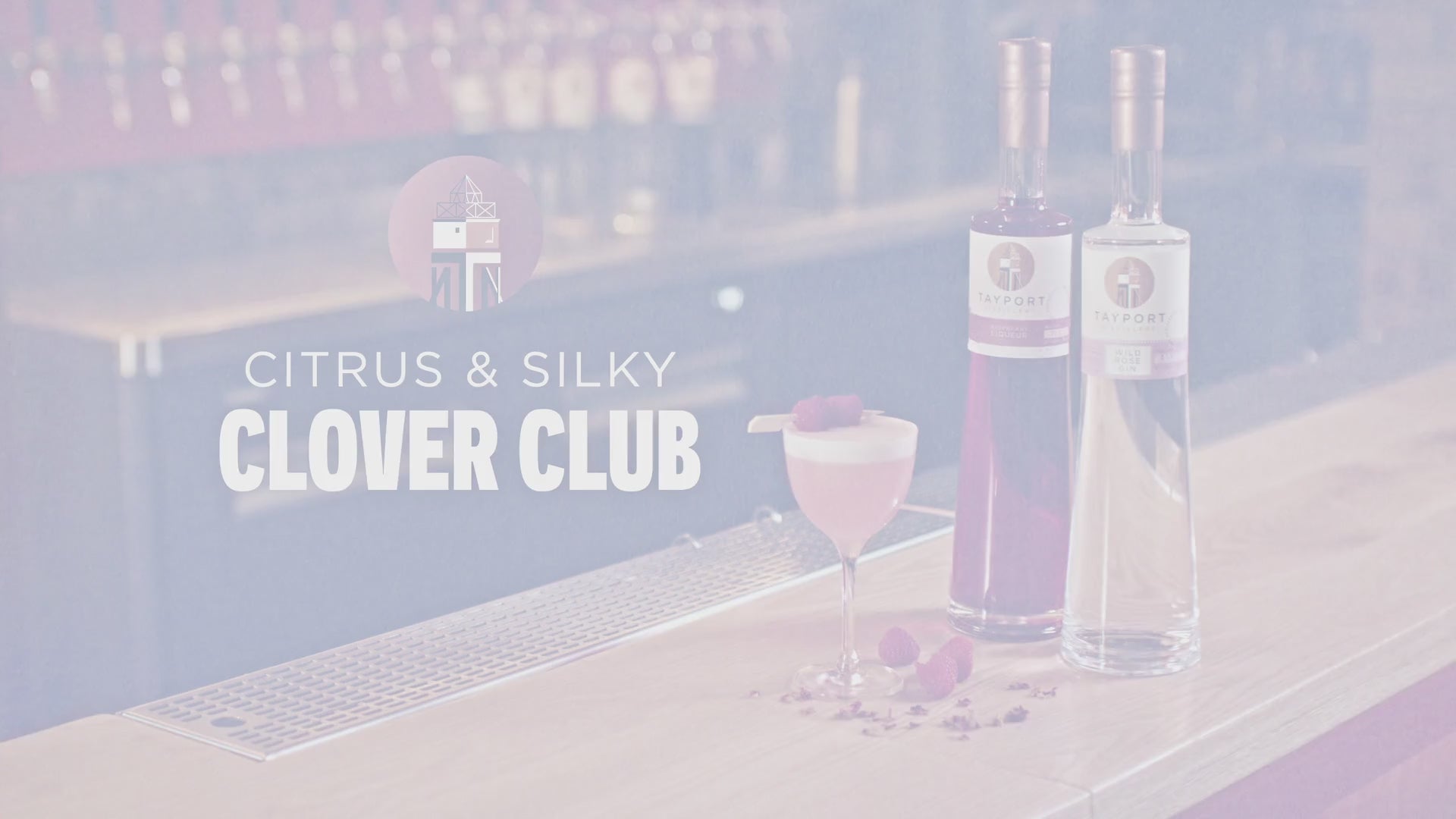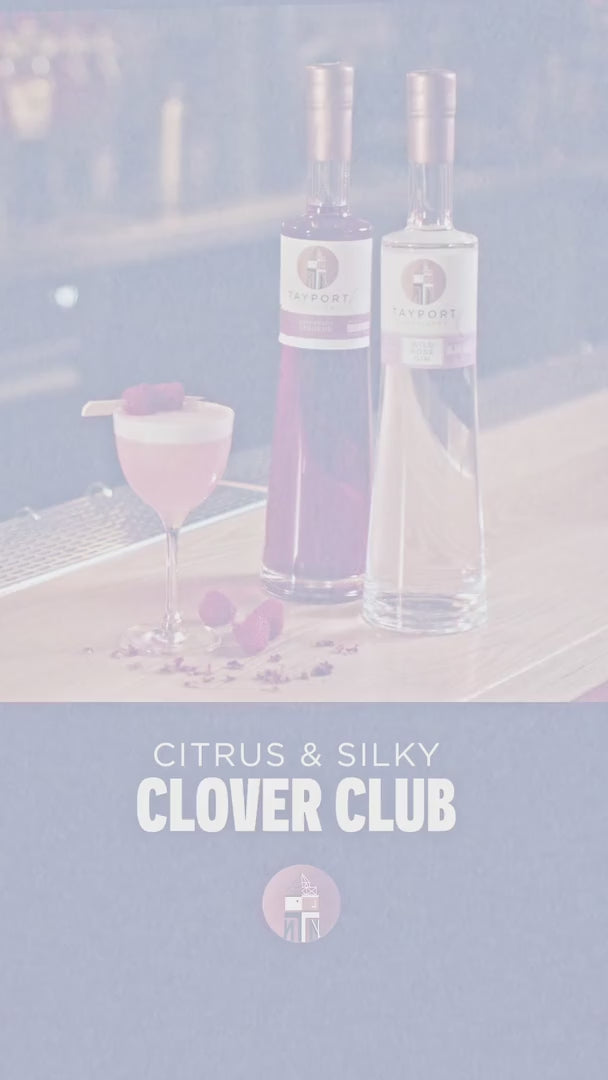The Clover Club Cocktail: History, Recipe & A Scottish Twist
Step into the captivating world of classic cocktails with the Clover Club. This visually stunning pink drink, crowned with its signature silky foam, is more than just a pretty face; it's a sophisticated blend of history, flavour, and technique. Once the toast of an exclusive Philadelphia club, the clover club cocktail has navigated the tides of time, from pre-Prohibition popularity to near obscurity and back to the forefront of the modern craft cocktail movement. The clover club story is a fascinating one.
Ready to uncover the story behind this iconic club favourite and learn how to craft the perfect version – a truly delicious clover club cocktail – complete with a unique Scottish twist using Tayport Distillery's exceptional spirits? Let's dive into the ultimate guide to the Clover Club.
What is a Clover Club Cocktail?
At its heart, the Clover Club is a gin sour elevated by the fruity kiss of raspberry and the luxurious texture imparted by egg white. It strikes a delicate balance between the botanical notes of gin, the tartness of fresh lemon juice, the sweetness of raspberry liqueur, and that unmistakable velvety mouthfeel. Its vibrant pink hue and frothy top make it one of the most aesthetically pleasing classic cocktails. Many agree it's simply a great clover club experience.
Origins of The Clover Club
The story begins not with a recipe, but with a place: The Clover Club, a prestigious Philadelphia men's club established in 1882. Meeting at the opulent Bellevue-Stratford Hotel, its members – writers, lawyers, financiers, the "captains of industry" – were men of influence and taste. Naturally, their gatherings involved sophisticated libations, and the eponymous clover club cocktail soon became a house favourite and a symbol of their exclusive circle within the various clover clubs of the era.
While the club predates the first printed recipes, mentions of similar concoctions began appearing in cocktail manuals in the early 1900s. J. A. Grohusko's Jack's Manual (1908) featured "A Clover Leaf," noted as popular in Philadelphia. Its recipe included London Dry Gin, sugar, raspberry syrup, lemon juice, and egg white, garnished with mint. The first known recipe explicitly titled "Clover Club Cocktail" appeared in Raymond E. Sullivan's The Barkeeper's Manual (1910). Some sources mention a clover club bar within Applegreen's Bar Book even earlier, showing its deep roots. For a time, the presence of the mint sprig distinguished the Clover Leaf cocktail from the Clover Club, a distinction later solidified by Harry Craddock in The Savoy Cocktail Book (1930).
Despite its blue-blooded origins and status as a fashionable clover club drink, its popularity waned mid-century, possibly due to the perceived difficulty of using egg whites or changing tastes. Thankfully, the modern cocktail renaissance, spearheaded by dedicated clover club bartenders and bars like Julie Reiner's Clover Club restaurant in Brooklyn, has resurrected this gem, allowing a new generation to appreciate its timeless elegance.
Understanding the Key Clover Club Ingredients
The magic of the Clover Club recipe lies in the synergy of its core ingredients. Quality matters here:
- Gin: The soul of the drink. A good quality Dry Gin provides the botanical foundation.
- Fresh Lemon Juice: Absolutely essential for brightness and balance. Its citrus tang cuts through the sweetness and richness.
- Raspberry Element: Traditionally raspberry syrup, this provides the signature colour and fruity sweetness. Using a high-quality raspberry liqueur elevates the drink.
- Egg White: The secret to the iconic velvety texture and stable foam.
The Tayport Distillery Difference: Superior Scottish Ingredients
For a truly exceptional Clover Club, we turn to Tayport Distillery, crafting premium spirits on the banks of the River Tay in Scotland. Their approach elevates the classic ingredients:
- Tayport Distillery Wild Rose Gin: This award-winning Scottish gin offers a unique twist. Infused with wild rose petals, it adds a delicate floral aroma and smooth complexity that beautifully complements the raspberry and lemon notes.
- Tayport Distillery Raspberry Liqueur: Forget basic raspberry syrup. This luxurious liqueur is crafted in small batches using the freshest, locally sourced Scottish raspberries. It delivers an intense, authentic berry flavour with a perfect balance of sweet and tart.
The Story Behind Scotland's Superior Raspberries
Tayport Distillery's commitment shines in their sourcing of Scottish raspberries, renowned for their flavour. This quality is underpinned by decades of work by the James Hutton Institute (formerly SCRI), whose raspberry breeding programme has been "phenomenally successful" globally. Developing cultivars like the famous 'Glen' series, the Institute helped the Scottish industry dominate the high-quality fresh market. Using raspberries benefiting from this legacy ensures Tayport's liqueur captures the true essence of premium Scottish fruit.
The Tayport Clover Club Cocktail Recipe
Ready to craft perfection? Here’s the definitive clover club cocktail recipe featuring Tayport Distillery:
Ingredients:
- 60ml Tayport Distillery Wild Rose Gin
- 15ml Fresh Lemon Juice
- 50ml Tayport Distillery Raspberry Liqueur
- 1 Fresh Egg White
- Garnish: Fresh Raspberries on a cocktail stick
Tip: You can purchase the Tayport Distillery Wild Rose Gin and Raspberry Liqueur together in our Clover Club Cocktail Gift Set.
Equipment:
- Cocktail shaker
- Jigger/measure
- Citrus press
- Strainer & Fine mesh sieve
- Chilled cocktail glass
Method:
- Chill Glass: Ensure your chosen cocktail glass is thoroughly chilled.
- Combine: Add the Gin, lemon juice, Raspberry Liqueur, and egg white to your cocktail shaker.
- Dry Shake: Secure the lid tightly and shake vigorously without ice for 30 seconds. This emulsifies the egg white.
- Wet Shake: Add plenty of cubed ice to the shaker. Seal tightly again and shake hard for 15-20 seconds until well-chilled.
- Double Strain: Pour the cocktail through both strainers (a standard Hawthorne strainer and a fine mesh sieve) into your chilled glass. This ensures a silky smooth texture.
- Garnish: Gently place the garnish onto the foam. Serve immediately.
Mastering the Technique: Tips for Clover Club Perfection
- Fresh is Best: Use fresh lemon juice and good quality egg white. The fresher the egg, the better the foam.
- Shake it Right: Don't underestimate the power of the dry shake (without ice) and wet shake (with ice). Both are crucial for texture and chill.
- Double Trouble: Double straining is non-negotiable for removing small ice shards and ensuring a perfectly smooth, velvety finish.
- Glassware Choice: A chilled coupe glass is classic and showcases the foam beautifully. A chilled Martini glass can also work. Choose the right glass for your club cocktail.
- Balance: Taste and adjust if needed. Some prefer slightly more tartness or sweetness. Making a great clover club is about finding your perfect balance.
Exploring Clover Club Variations
While the classic recipe is sublime, feel free to experiment with drinks like clover club:
- Spiced: Add a tiny dash of cinnamon or nutmeg during shaking for a warming note.
- Tropical: Introduce a splash of pineapple juice or a bar spoon of passionfruit syrup for an exotic twist.
- Berry Swap: Substitute Tayport's Raspberry Liqueur with their equally delicious Blackcurrant Liqueur for a different berry profile.
- Gin Journey: Try the recipe with different gin styles (e.g., Old Tom for slight sweetness, Plymouth for earthiness) to see how the base spirit changes the drink.
Clover Club vs. Other Classic Cocktails
How does the Clover Club stack up against other vintage cocktails? Is anything else the same as clover club?
- Pink Lady: Often confused due to the pink colour and egg white, the Pink Lady typically includes applejack (or apple brandy) and grenadine instead of raspberry, resulting in a different flavour profile. Not the same as clover club.
- Gin Sour: The Clover Club is essentially a classic Gin Sour (gin, lemon, sugar, egg white) with the crucial addition of raspberry (syrup or liqueur) for fruitiness and colour.
- White Lady: Another classic egg white gin sour, the White Lady uses Cointreau or Triple Sec instead of raspberry, resulting in a pale, orange-scented drink.
Perfect Pairings: What to Serve with your Clover Club
Enhance your Clover Club experience with complementary flavours:
- Savoury: Light cheeses (like goat cheese or feta), smoked salmon canapés, prosciutto-wrapped melon, or delicate shrimp cocktails.
- Sweet: Lemon tart, raspberry macarons, white chocolate desserts, or simple shortbread biscuits.
- Vegetarian: Cucumber sandwiches with cream cheese, creamy dips (like hummus or white bean dip) with fresh crudités, or bruschetta with ricotta and berries.
Embrace the Elegance of the Clover Club
The clover club cocktail is a true classic, a testament to balanced flavours and sophisticated presentation. Its revival is well-deserved, showcasing a perfect blend of tart, sweet, botanical, and creamy notes. By crafting this timeless clover club recipe with Tayport Distillery's unique spirits – enriched by Scotland's finest raspberries – you elevate the experience from merely making a drink to creating a moment. This is how you create a delicious clover club cocktail.
Gather your ingredients, embrace the technique, and treat yourself (and your guests) to the sophisticated charm of the Clover Club. Cheers!
Frequently Asked Questions (FAQ)
What does a Clover Club taste like?
It's a balanced blend of gin's botanicals, tart lemon juice, sweet and fruity raspberry, all enveloped in a smooth, creamy, velvety texture thanks to the egg white.
Do I have to use egg white?
Traditionally, yes. However, if you prefer not to, you can use alternatives like aquafaba (the liquid from canned chickpeas) or commercial cocktail foamer products. The texture might differ slightly, but they can create a similar frothy top.
What's the difference between a Clover Club and a Clover Leaf cocktail?
Historically, the main difference was the garnish: the Clover Leaf included a mint sprig floated on top or alongside the raspberries, while the Clover Club typically did not. This distinction is less common today.
What is the alcohol content?
The exact alcohol content (ABV - Alcohol By Volume) will vary based on the specific proof of the gin and the alcohol percentage of the raspberry liqueur used. Generally, it falls into the typical range for classic gin-based cocktails like a Martini or Gin Sour, often around 20-25% ABV depending on the specific recipe proportions.



